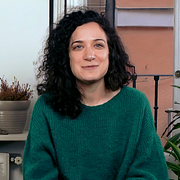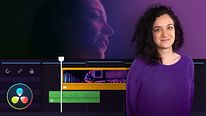Color Grading with DaVinci Resolve
Course final project
A course by Sonia Abellán Avilés , Colorist
About the final project for: Color Grading with DaVinci Resolve
Color Grading with DaVinci Resolve
“My final project During the course, I did the color grading of the short film Piscina, directed by Carlos Ruano and photographed by Enrique Silguero. It's about two friends spending a hot summer day in Madrid, looking for a pool to cool off in and everything happens while one of them is worried about something he doesn't know how to tell his friend. The short film seeks to convey the stifling heat of the summer in Madrid where you don't know where to go to cool down and joins the anguish of one of the characters who is overwhelmed without knowing how to tell his friend something. While they talk and look for a pool to swim in, they find a cool place to spend some time. This second location seeks to convey freshness, cleanliness, something neutral, and is where the character resolves the conversation with his friend. The aspects of the project To achieve all this, we have sought two different temperatures, the outside, warm with a clear dominance of yellow and the interior cold and more bluish. Two textures and sensations have also been sought, the dense and marked exterior and the soft and light interior. Accompanying the character's sensations. When facing this project we know that we have two worlds to achieve. We chose a representative foreground with which to work and choose the look of the exterior. The general plane is perfect for that. We did several tests to see how the material behaved and in the end, we decided that we would work with a LUT that we neutralized with a previous node so as not to be too conditioned. We raised light and removed contrast and saturation in that first node and together with the LUT we have an image that gives us a feeling and texture that brings us closer to the world we are looking for. In general, we work the image warming up and taking it to warm tones, we will take halftones and high lights to yellows and oranges. We contrast and lower little high lights to make it a more dense atmosphere. For more detail, we work on the secondaries and make selections. In the first sequence, we look for the dense sky, removing the blue to get that suffocating daytime sky. In order not to lose the green, we select it and keep the colour so that it is not too yellow or a cold green outside the warm world. The result This first sequence is more contrasted helping to give density to the feeling of heat and placing the scene in a hot hour of the day.


Partial transcription of the video
“Hi. Let's see a little summary than what we have seen during the course. First of all, I have told you a little about myself so you know me better. Afterwards, we have seen my influences, the things that I like. We have continued with color theory to understand a little its importance in the world of cinema. Then we have started to open DaVinci. We have seen a little of its configuration and we have already taken a walk through its interface. We have seen the Media tab to see how to import and manage all the files that we will use later. Then we have gone to Edit, that although we are not g...”
This transcript is automatically generated, so it may contain mistakes.
Course summary for: Color Grading with DaVinci Resolve
-
Category
Photography & Video -
Software
DaVinci Resolve -
Areas
Audiovisual Post-production, Color Correction, Film, Film, Video & TV, TV, Video, Video Editing

Sonia Abellán Avilés
A course by Sonia Abellán Avilés
Sonia initially started out in the graphic design field, but it didn't take her long to realize that it was moving images that really inspired her. She undertook a variety of different audiovisual production and post-production roles before deciding to specialize in color grading.
She currently works on a freelance basis, although she spent four years at the El Colorado studio, where she participated in the color grading for film and television projects such as Villaviciosa de al lado, Morir, Sara's Notebook, and the series Pulsaciones. She has also colored documentaries, programs such as Wild Frank, short films like Piscina, and countless commercials.
- 89% positive reviews (528)
- 15,885 students
- 24 lessons (4h 55m)
- 25 additional resources (10 files)
- Online and at your own pace
- Available on the app
- Audio: Spanish, English, French, Italian, Portuguese, Turkish
- Spanish · English · Portuguese · German · French · Italian · Polish · Dutch · Turkish · Romanian · Indonesian
- Level: Beginner
- Unlimited access forever
- Updated on 07/28/2020
Category
Areas




